Capabilities of your smartphone far exceed calls and social networking. You can mine Dogecoins, see how a new sofa fits in your room before buying it, control your thermostat from afar, or get your coffee ordered by chatbots. This is how the power of mobile apps transforms the way we handle things in 2018. So if you were looking for a chance to catch up on app trends, the time is now.
Mobile matters
As reported by Statista, global mobile app revenues are projected to rise to 189 US billion dollars by 2020. The data of the researchers differ, but on the whole one conclusion can be traced: about half of the world population have got smartphones and access to mobile devices to another half is just a matter of time. With the increasing number of smartphone users, the growth spurt in app revenues is sure to continue.
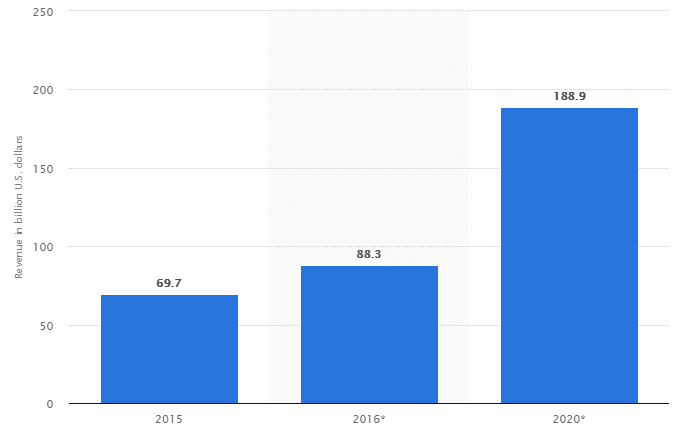
The soaring number of smartphone users has naturally led to a staggering increase in the number of apps that customers use on their devices. 2017 saw more than 178 billion mobile app downloads with an upward trend to 258 billion in 2022.

Google Play alone currently boasts around 4.1 million apps, followed by its main competitor Apple App Store with around 2 million apps.
As user behavior is rapidly changing, companies must also adapt to the latest trends in order to meet the needs of their customers.
So what does mobile future has in store for us?
Blockchain is the new black
2017 Blockchain popularity skyrocketed with more attention drawn to it than to any other technology.
Here is was Statista says for «size of the blockchain technology market worldwide»:

And it seems that back in 2016 people were hardly aware of the thing.
Now, according to IBM research, “nine in ten government organizations plan to invest in blockchain for use in financial transaction management, asset management, contract management and regulatory compliance by 2018.”
Analysts from Research and Markets, in turn, expect that by 2020 around 65 percent of all companies will use blockchain technologies.
As a result, Google Play and Apple App Store see a continuous increase in new blockchain-related applications.
Today mobile blockchain apps are mostly wallets and currency calculators. However, some of them are really worth having a closer look:
Civic allows you to securely register and confirm personal data to partner websites for account sign up and access. For this, it leverages technologies that no longer require legacy usernames and passwords. It is designed to avoid fraud with credit history and information theft.
‘If Civic was to ever get hacked, your information would never be released because we just don’t have it.’
Vinny Lingham, co-founder, and CEO of Civic- Verisart employs blockchain security to certify and verify artworks and collectibles. It also allows creative people to protect copyright.
- With the Slock.it application, you can rent IoT devices: find them, locate and monitor them using smart contracts.
And we surely could not forget about mining mobile apps.
Recently, some Android apps that help you mine cryptocurrency have appeared. DroidMiner BTC/LTC/DOGE Miner, Electroneum, and ARM Miner Bitcoin are just a few examples.
There have been even a few mining apps that managed to sneak to App Store, although Apple hurried to remove them out. Calendar 2 had a crypto mining feature, but because of Apple’s concerns over the app’s power-efficiency, the developers had to get rid of the mining feature.
If you are looking to build your blockchain-based app, go no further. We know a thing or two about secure blockchains, smart contracts, and their real-life applications. So contact us for a free quote!
Sick of just one reality?
The Consumer Electronics Show (CES) in Las Vegas gave an initial outlook that AR and VR could be one of the hottest trends of the 2018 mobile year. Combined, the AR marketplace and gaming MVR marketplace were displayed on the area of 45.000 net square feet of exhibit space.
And that’s not really surprising.
According to Digi-Capital, the revenues of augmented reality could increase from 85 to 90 billion dollars by 2022. Meanwhile, virtual reality might generate from 10 to 15 billion dollars.
The remarkable success of Pokemon GO showed the true potential of generated realities. For this reason, both Google and Apple are actively improving the compatibility and capabilities of mobile devices in this area.
In June 2017, Apple introduced the ARKit platform (and ARKit 2 in 2018), simplifying the development of iOS-applications with augmented reality. After a couple of months, Google released a similar solution for Android - ARCore.
However, AR is not only a source of fun but a valuable assistant in practical tasks. For example, a popular language-learning app Mondly makes use of AR to bring the virtual language assistant right to where you are.
Google Translate has also benefited from adding an AR feature, Word Lens. Now it is possible to turn on the camera mode within the software and make a pic of the lines you would like to translate. The rest will be done by the app.
Magic Leap, Microsoft, Meta, ODG, Mira, and DAQRI have already introduced their AR headsets. At the same time Apple, Google, Facebook, and Snap are actively engaged in developing a smartphone-based AR.
The market for augmented reality applications will primarily focus on retail, healthcare, engineering, and real estate. The technology’s value lies in the fact that the customer can test the utility of a product or service before making a transaction. It provides a personal experience, which is one of the main drivers of sales.
One of the pioneers is Ikea Place, which enables its customers to have a 3D view from different angles of over 2,000 products.
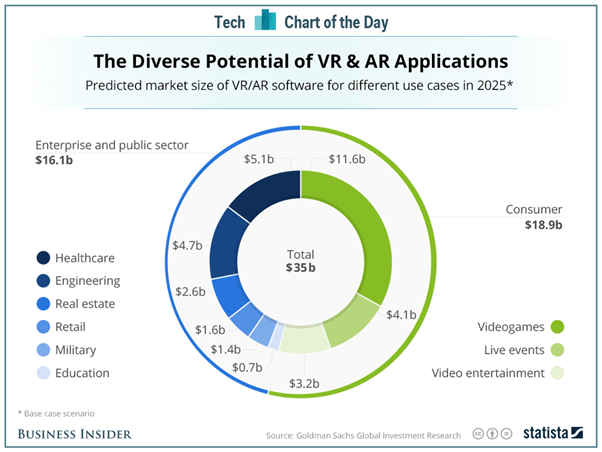
As for the virtual reality, it will continue to be widely implemented in the gaming and entertainment fields. The world is looking forward to the new Harry Potter game by the developers of Pokemon GO.
2018 will certainly have us seeing new exciting developments in mobile apps, with the borders between the reality and virtual world blurring further.
Staying connected
The Internet of Things wave has certainly reached us and placed the IoT apps in a most favorable position.
Mobile app experts predict that 2018 will be a breakthrough year for the IoT market. And integration of IoT with automation technology will be the main trend in the development of mobile applications.
We cannot appreciate the trend without actually looking at the market perspectives.
For comparison:
Internet of Things market amounted to $170 billion in 2017 and is projected to reach 561 USD billion by 2022. The number of connected devices is set to rise from 20 billion in 2015 up to 42 billion in 2022, as shown by Statista.
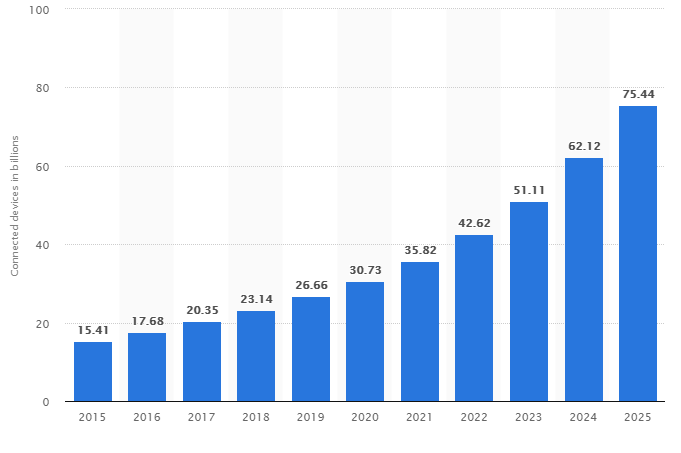
The scope of industries taking advantage of IoT is also somewhat impressive.
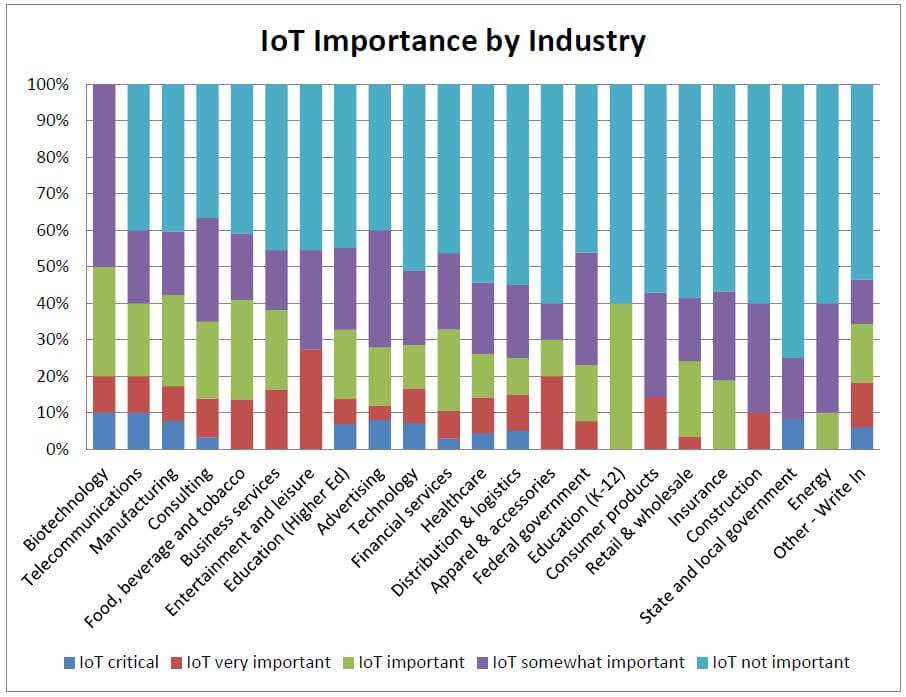 Source: Forbes.com
Source: Forbes.com
Yet we still have to control all this. And this is where apps show up.
To ease the process of IoT app development both Google and Apple came up with their own toolkits - Brillo and HomeKit respectively.
To have a better idea of what IoT apps actually are, let’s have a closer look at some cool examples of them.
- Nest allows users to monitor all IoT devices at their homes right from their hands with the help of a dedicated app. You can control your thermostat, arm or disarm the alarm system, see what is going in your home with a camera and be aware of whether your protect alarm is triggered.
- Blossom is a smart-watering system that employs real-time weather data to adapt your watering plan. The system consists of a Bluetooth-powered controller and a mobile app, that makes it easy to install and manage.
- Pawscout empowers you to track your pet’s whereabouts. The device, namely a Bluetooth Low Energy (BLE) GPS tag is attached to a pet’s collar and connects to the mobile app. Other features include digital pet profiles and medical records, the online community for pet owners or a map with pet-oriented places.
The flourishing wearables market is immensely contributing to the popularity of IoT apps.

The interest is in large driven by the latest wearables solutions like Apple Watch with eSim, Garmin Forerunner 935, Xiaomi Mi Band 3 or Google Glasses 2.0.
Swapping wallets
A good old leather purse can soon be a vestige of the past. About 2.1 billion consumers worldwide will use a mobile wallet to make a payment or send money in 2019. This is a nearly 30% increase from 1.6 billion recorded at the end of 2017 - a new study from Juniper Research suggests.
Mobile wallets were first promoted in 2014 with Apple introducing Apple Pay on its gadgets. The example was quickly followed by Samsung Pay, Android Pay, and Microsoft Wallet.
As of 2017, these apps made it to the forefront of the mobile payment industry:
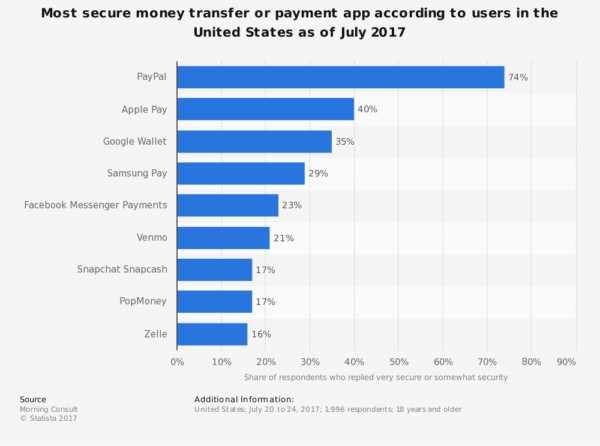
During CES 2018, Google Wallet and Android Pay rolled into a single platform called Google Play.
‘With Google Pay, it’ll be easier for you to use the payment information saved to your Google Account, so you can speed through checkout with peace of mind.’
Vice President of Product Management for Payments Pali Bhat announced in a Google blog post
According to Allied market research, the mobile payments market size is predicted to reach $4,574 billion by 2023. Part of what has stimulated this trend is the inclusion of mobile wallets in the most popular phones, as well as wide acceptance of such software by its users.
For companies, this is a great way to collect data and analyze customers, and for customers - a more clear sailing way to pay for purchases. The product you want is just a few taps away. As they say, time is money. Right?
Those who have not yet considered mobile wallets as an option for their customers should definitely do so in 2018.
Meanwhile, mobile payment and banking apps are also…
Going Artificial?
With the introduction of AI, customers' expectations concerning individual experience and interactivity have also shot up, making it another craze for the upcoming years.
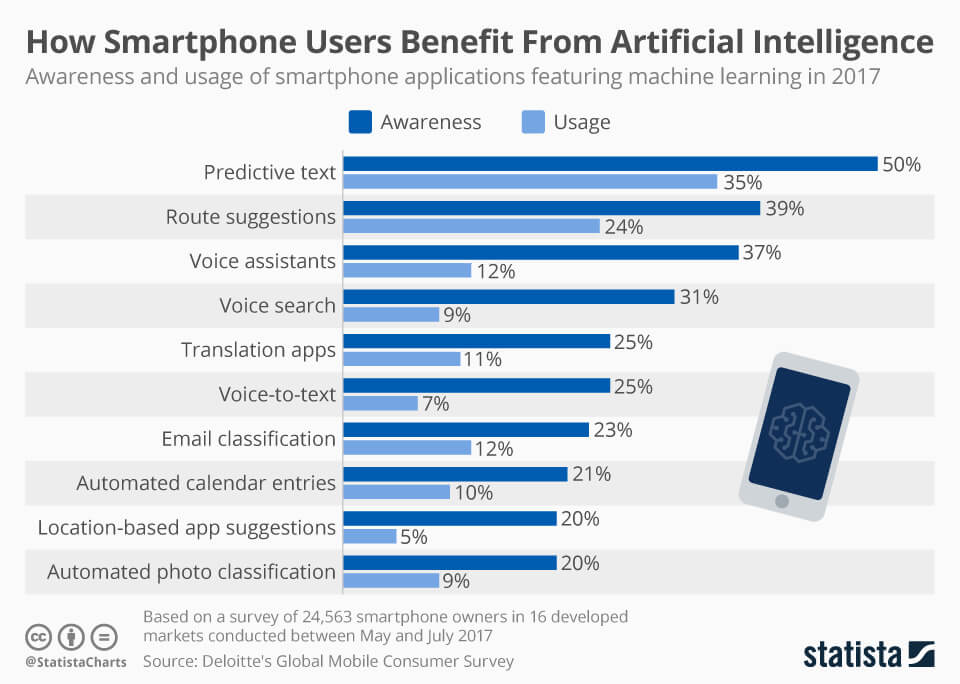
And the market is definitely reaping these rewards:
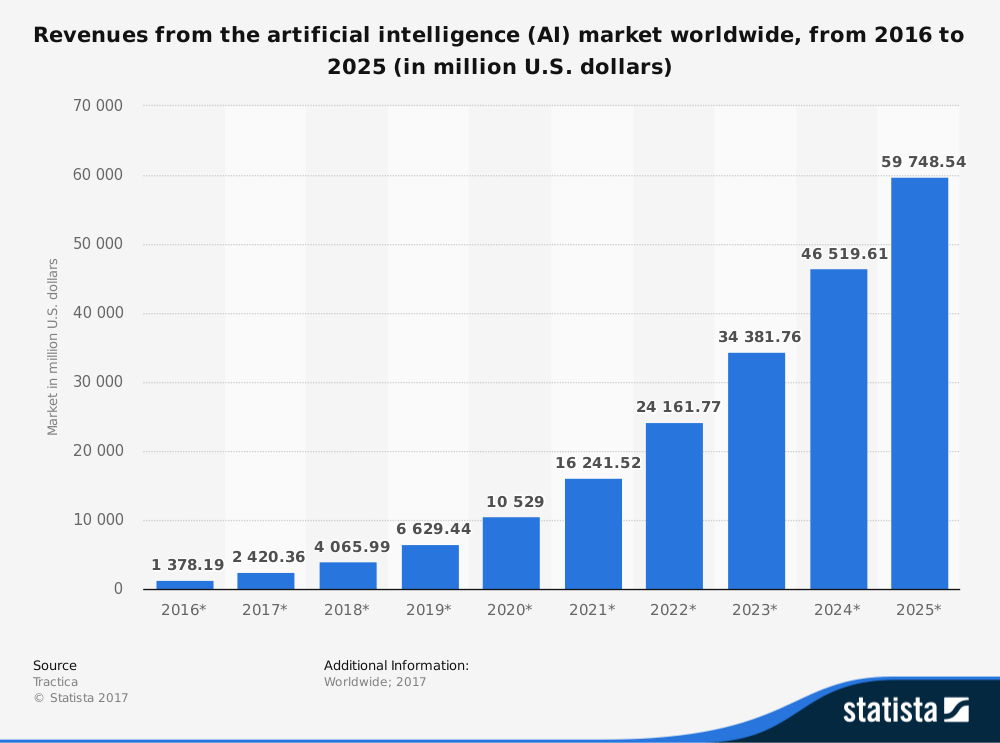
Сhatbots were among the favorite applications of AI in recent years. Now they are making their way to mobile to become a commonplace attribute of 2018.
According to Ubised research, over 50 % of the people believe that businesses should be available for them around the clock. So Bank of America is currently rolling out its Erica mobile banking chatbot.
‘Everything we do is based on what we hear from our clients: how they want to interact with us and how we can make their financial lives better. Erica delivers on this in many ways, from making it easy for clients to find what they are looking for to providing new and interactive ways to do their banking using voice, text or gesture. Through Erica, we are also delivering personalized solutions at scale by providing insights, such as how you can improve your credit score or create a budget.’
Michelle Moore, Bank of America Digital Banking Manage
The e-learning industry is also gripping the advantages of chatbots. They assist users in a variety of tasks from foreign language study or feedback gathering to improving corporate learning experience.
Juniper Research believes that chatbots will result in more than $8 billion in cost savings per year from now to 2022. This is an increase from the $20 million in 2017.
AI-powered solutions are generally associated with providing customers with a more personalized experience.
For example, Starbucks came up with its “My Starbucks Barista” mobile app. Customers need to just tell what they want and the order is placed for them.
Taco Bell went even further and outshined automated ordering. Their new tool Taco Bot recommends personalized menu options by analyzing user purchase behavior.
Pure machine learning can be further represented by Netflix, which leverages algorithms adapting to user behavior for perfect personal recommendations. There is also Tinder, that reorders you photos based on their popularity, assisting you in finding your soulmate.
Gartner predicts that by the 2018 world’s largest 200 companies will take advantage of AI apps to refine their offers and increase profits.
Android Instant Apps
Android instant apps were first presented at Google I/O 2016 but became generally available to all Android developers only in 2017.
What are they for?
Well, look at this:

This is a percentage of mobile apps that have been used only once during the first six months of ownership from 2010 to 2017.
Android Instant Apps give you the opportunity to launch apps right away, without actually installing them on your smartphone.
The course of action is simple. You just have to choose an app in Play Store and tap “Try it now” button. Once it loads up from an URL, you can use it like any other app. The same is true for any in-app shared links.
While it looks like a better experience for end-users, businesses can also benefit from the thing. Just think about the increased number of potential customers who are more likely now to try out your app due to pages sharing option and better discoverability.
New phones - new rules
The hype over iPhone X made bezel-less design one of the most relevant trends for the upcoming year. The ending of the physical Home button era, a fundamentally new screen shapes and dimensions offer its users more display space for better content immersion.
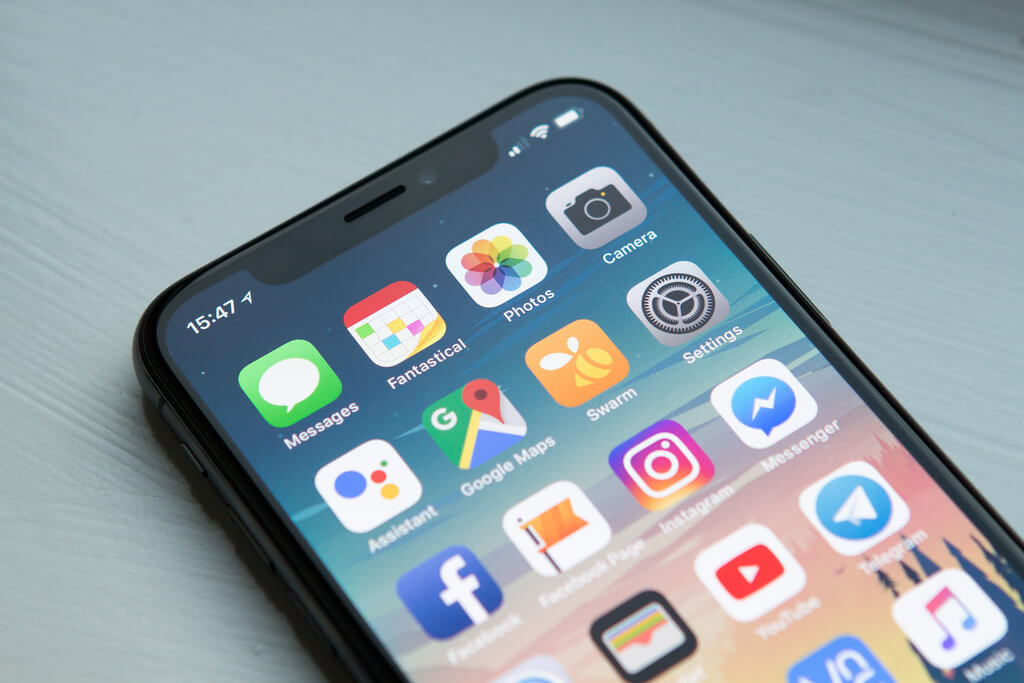
iPhone X’ "notch" also makes app designers find ways to accommodate it in style.
‘Don't attempt to hide the device's rounded corners, sensor housing, or indicator for accessing the home screen by placing black bars at the top and bottom of the screen.’
Apple guidelines
To reinforce the trend Apple issued the following statement:
‘Starting July 2018, all iOS app updates submitted to the App Store must be built with the iOS 11 SDK and must support the Super Retina display of iPhone X.’
GDPR

If you are also fed up with hearing phrases like “data leakage” or “hacker attack” then we have good news for you. 2018 takes mobile app security to a whole new level.
The EU’s General Data Protection Regulation (GDPR) took effect on May, 25. It changes the way in which apps are authorized to collect, use, and store personal data and how straightforwardly should they ask for collecting the data in the first place. It also stipulates that users must have access to easily opt-out and remove their data whenever they want to.
Make sure you know how to follow the directive’s guidelines by checking our GDPR compliance checklist.
Or click here for examples of what a good custom app development company can do.
Recommended posts
Our Clients' Feedback


















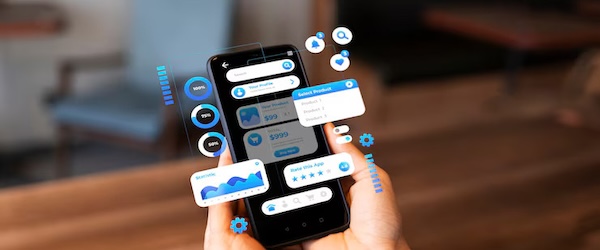
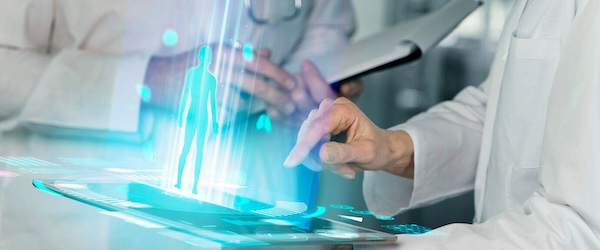
.jpg)
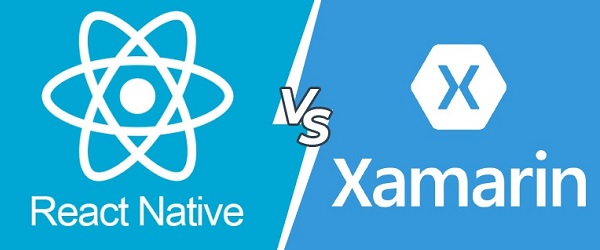

![How to Create a Language Learning App [The Ultimate Guide!]](/uploads/images/blog/posts/previews/image_155352483594-image(600x250-crop).png)
.jpg)

.png)
.png)
.jpg)
.jpg)
.jpg)
.jpg)
.jpg)
.jpg)
.png)
.jpg)
.jpg)
.jpg)
.png)
.jpg)
















We have been working for over 10 years and they have become our long-term technology partner. Any software development, programming, or design needs we have had, Belitsoft company has always been able to handle this for us.
Founder from ZensAI (Microsoft)/ formerly Elearningforce